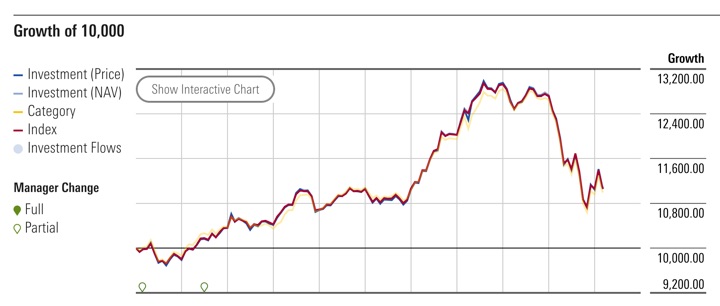 Per Wikipedia, a financial “hedge” is an investment position intended to offset potential losses or gains that may be incurred by a companion investment. Wouldn’t be nice if for every Investment A, there was another Investment B that would always move in the opposite direction? Unfortunately, things aren’t so easy.
Per Wikipedia, a financial “hedge” is an investment position intended to offset potential losses or gains that may be incurred by a companion investment. Wouldn’t be nice if for every Investment A, there was another Investment B that would always move in the opposite direction? Unfortunately, things aren’t so easy.
Here a reader e-mail that I definitely empathize with:
While I understand the dangers of performance-chasing, I’m getting more and more annoyed that bonds don’t do their jobs at stabilizing my portfolio. Last few years, they seem to have a positive correlation with stocks.
Things I’d love to better understand:
– say an ETF like BND, wouldn’t the fact that we know interests will be high for some foreseeable future already baked in the price of BND?
– Moving away from bonds at this point seems “late to the party” and market-timing…but like I said, I’m getting increasingly annoyed
– What could be good alternatives? What about dividend stocks such as the VIG ETF or some REITs?
Here’s a related excerpt from the Institutional Investor article Here’s Proof That Stocks Were Never an Inflation Hedge (emphasis mine):
Years of outsize returns also lulled investors on the correlation between stocks and bonds. Fixed income has historically acted as a portfolio stabilizer when markets are declining. When stocks tank, bonds have done well. But that correlation has changed over time.
From 1900-1949, Marsh explained, Credit Suisse found that the average correlation between stocks and bonds globally was 0.45, while from 1950 to 1999, the relationship had a correlation of 0.34.
As the authors wrote in the report: “The recent fortunes of 60/40 equity/bond strategies are a painful example of this, having trusted too heavily in the recent negative correlations between the two assets rather than properly consulting the history books.”
Here’s a direct quote from the Credit Suisse Global Investment Returns Yearbook 2023 (emphasis mine):
Many investors were caught off balance by the simultaneous fall in stocks and bonds and the poor performance of a classic 60:40 equity-bond portfolio (see Chapter 4). Over the previous two decades, investors had grown used to stocks and bonds providing a hedge for each other. However, we cautioned last year that this had been exceptional in the context of history. The negative correlation had been associated with a period of falling real interest rates, mostly accommodative monetary policy and generally low inflation, and we pointed out that “change was in the air.”
While bonds have had short periods of negative correlation with stocks, unfortunately the long term correlation is still moderately positive. In other words, bonds still tend to move in the same direction as stocks, just not as much. Bonds do have a stabilizing effect, but aren’t always an offsetting hedge to stock market drops.
I like to keep in mind that as interest rates rise, that means that the Fed has more room to cut rates quickly if a true recession occurs again and inflation cools. The Vanguard Total Bond ETF (BND) covers nearly the entire taxable bond universe and thus includes lots of different maturities with an average effective duration of about 6.5 years.
A useful rule of thumb is that for every 1% change in interest rates, the value of the bond will either increase or decrease by the same amount as its duration. So a 1% rate hike and it will go down 6.5%, and a 1% rate cut and it will go up 6.5%. If you want things more chill, you may want to pick a short duration and accept the lower returns.
If you zoom out on the Growth of $10,000 chart for the Vanguard Total Bond ETF, you can see it going up from the rate cuts and back down with the rate hikes. $10,000 invested in 2013 is worth about $11,000 today. That’s not a great rate of return but the ride was smooth compared to other asset classes, and with shorter-term bonds, it would have been even milder.

Higher yields also mean higher future returns. You may want to reconsider bailing out of bonds now. The Morningstar article The Return of the Bond Market summarizes the dynamic well:
Bonds have been painful and frustrating and have required a ton of patience.
But now the market has recalibrated, and yields have reset higher. Higher yields mean higher future returns. And for the first time in a while, you can make the argument that bonds provide true competition to stocks.
But a key aspect of the bond market is interest rates adjusting higher from zero, hurting most at the beginning. An increase in rates from 4% to 5% will be much less dramatic than the move from 1% to 2%, for the simple fact that if you’re getting paid a coupon of 4% to 5% and you reinvest, it has a tremendous compounding effect that isn’t replicated with 1%–2% yields.
In the end, I can’t predict future interest rates. If you want less sensitivity to interest rates, you should own shorter-term bonds or even just money market funds. Just know that if/when rates go down again, then BND will go back up a lot more than the money market fund. I personally hold a mix of cash/money market, short-term, and intermediate-term US Treasury bonds, CDs, and cash. I keep my overall average duration to less than 5 years. My overall yield is now close to 4%, rather than than 2%. These particular assets have a job in my portfolio as stabilizers, and I see them as still doing their job despite the losses when rates go up.
 The Best Credit Card Bonus Offers – 2025
The Best Credit Card Bonus Offers – 2025 Big List of Free Stocks from Brokerage Apps
Big List of Free Stocks from Brokerage Apps Best Interest Rates on Cash - 2025
Best Interest Rates on Cash - 2025 Free Credit Scores x 3 + Free Credit Monitoring
Free Credit Scores x 3 + Free Credit Monitoring Best No Fee 0% APR Balance Transfer Offers
Best No Fee 0% APR Balance Transfer Offers Little-Known Cellular Data Plans That Can Save Big Money
Little-Known Cellular Data Plans That Can Save Big Money How To Haggle Your Cable or Direct TV Bill
How To Haggle Your Cable or Direct TV Bill Big List of Free Consumer Data Reports (Credit, Rent, Work)
Big List of Free Consumer Data Reports (Credit, Rent, Work)
Is Credit Suisse to be relied on anymore?